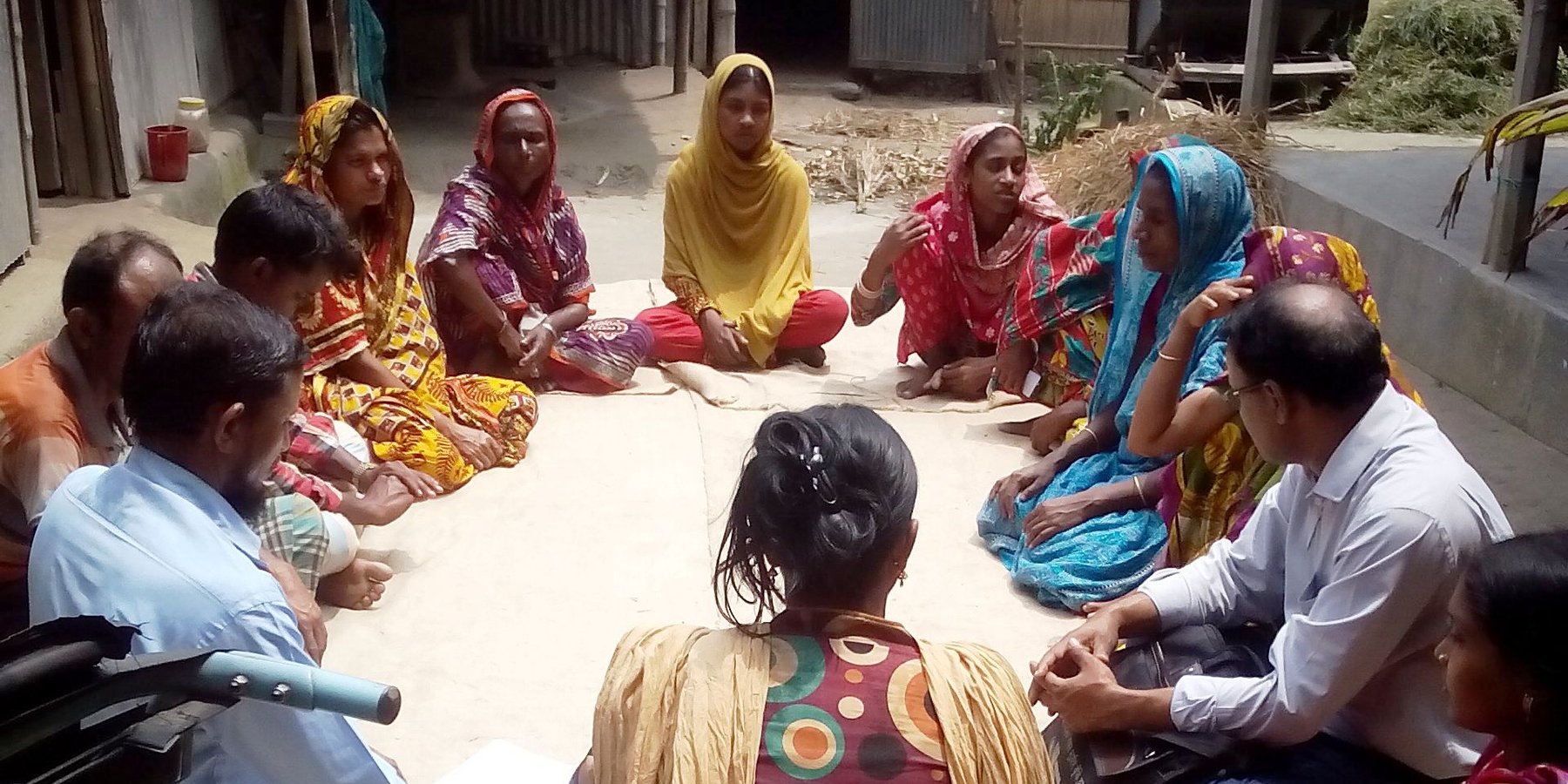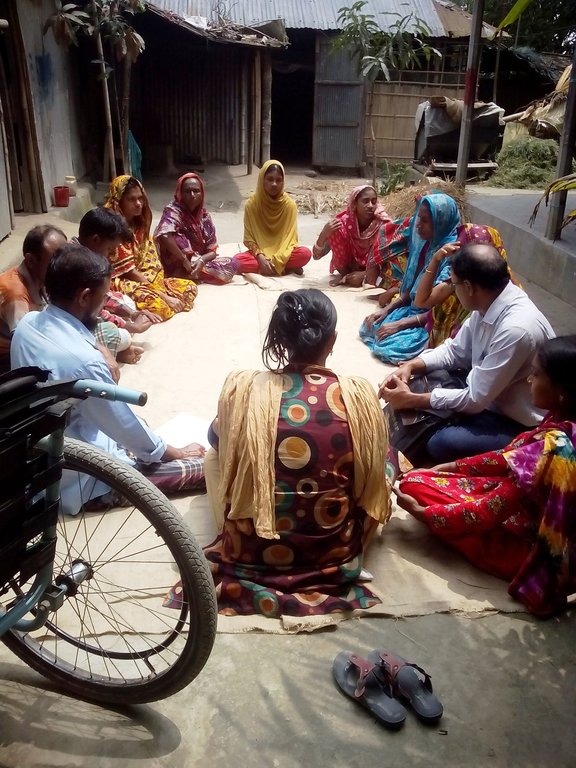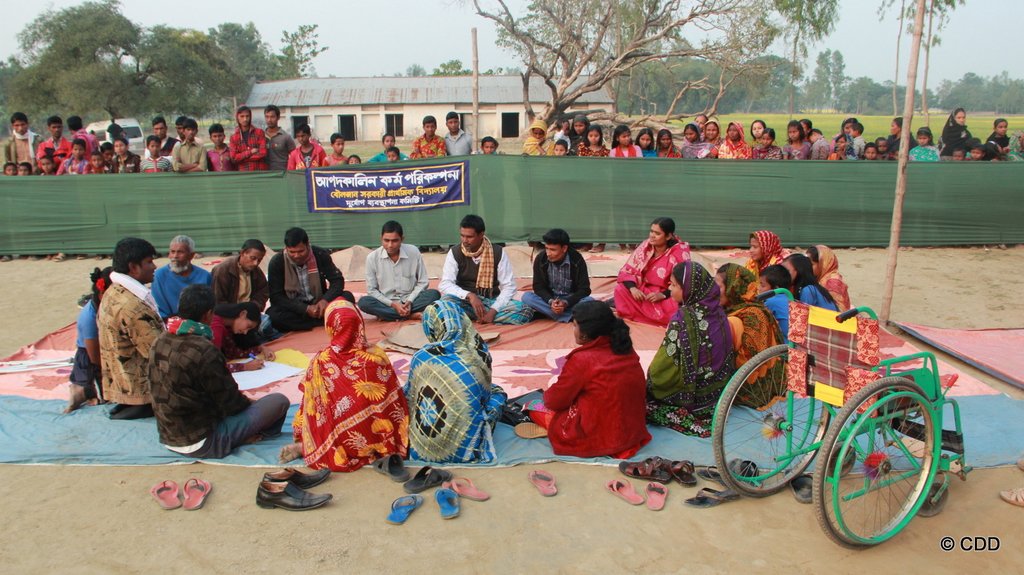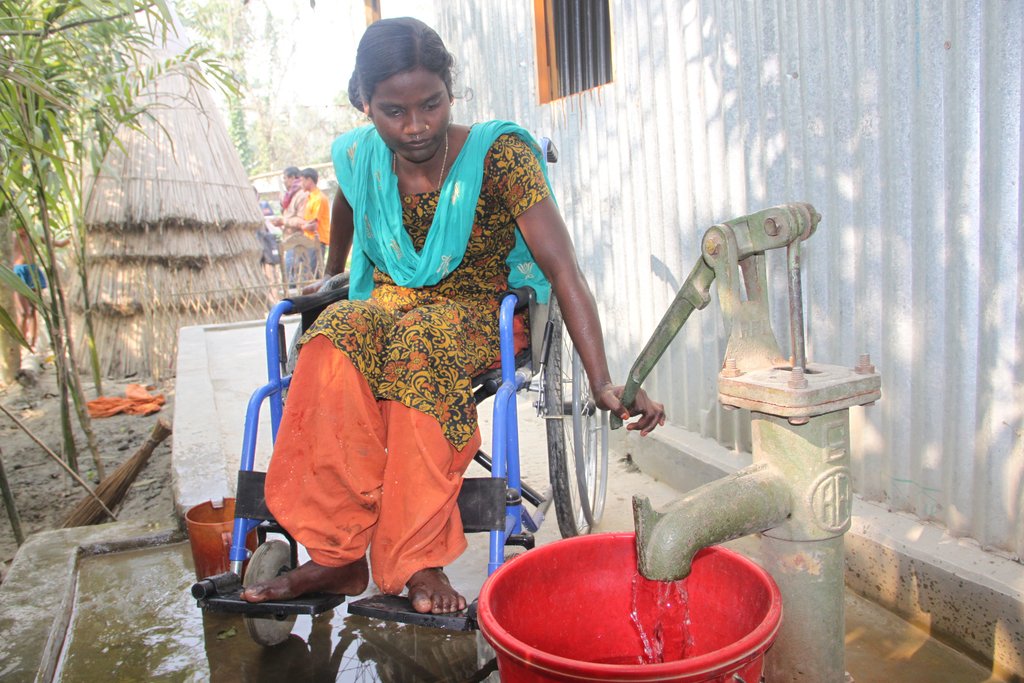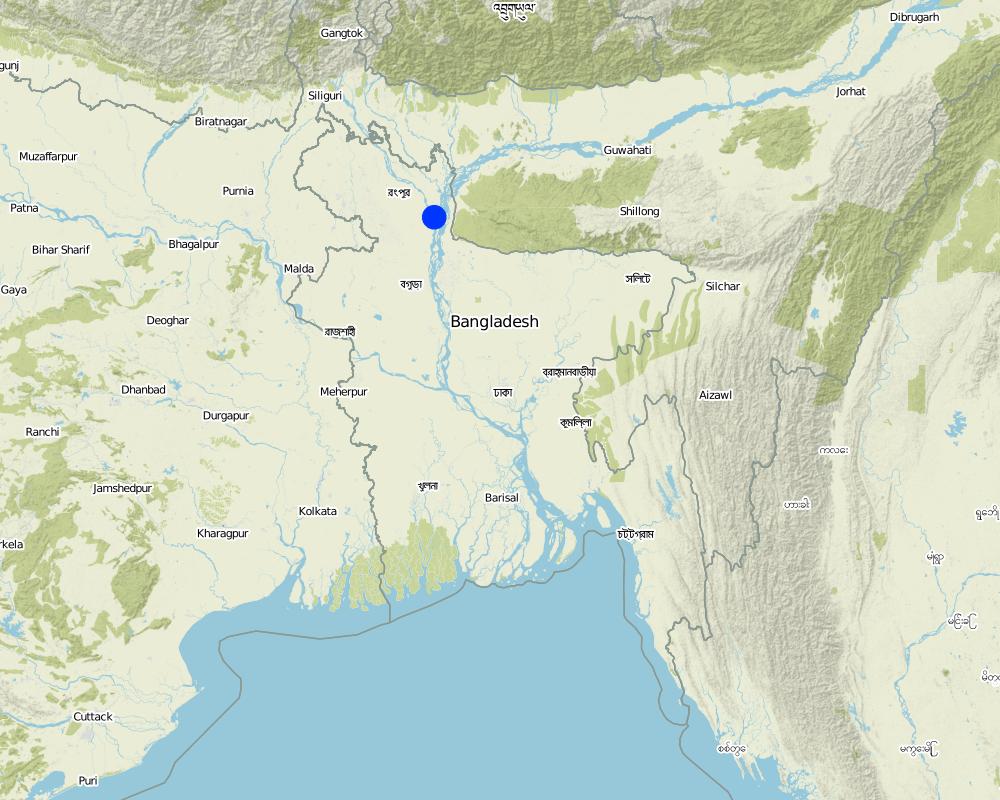Disability inclusive Disaster Risk Reduction [Bangladesh]
- Creation:
- Update:
- Compiler: Subir Saha
- Editors: Manuel Rothe, Subir Saha
- Reviewer: Alexandra Gavilano
Protibondhita Bandhob Durjog Jhuki Rash
approaches_2001 - Bangladesh
View sections
Expand all Collapse all1. General information
1.2 Contact details of resource persons and institutions involved in the assessment and documentation of the Approach
DRR specialist:
Islam Shahidul
+8801733143435
shahidulpls@yahoo.com
Centre for Disability in Development (CDD)
Gaibandha
Bangladesh
DRR specialist:
Dey Ashutosh
880-2-9887251 / +8801787662993
ashutosh.dey@cbm.org
CBM
Country Coordination Office CBM International H # 12 (GF) R # 2/A, Block-F Banani, Dhaka-1213
Bangladesh
DRR Specialist:
Name of project which facilitated the documentation/ evaluation of the Approach (if relevant)
Book project: where people and their land are safer - A Compendium of Good Practices in Disaster Risk Reduction (DRR) (where people and their land are safer)Name of the institution(s) which facilitated the documentation/ evaluation of the Approach (if relevant)
Christoffel Blindenmission (CBM) - Switzerland1.3 Conditions regarding the use of data documented through WOCAT
When were the data compiled (in the field)?
09/11/2016
The compiler and key resource person(s) accept the conditions regarding the use of data documented through WOCAT:
Yes
1.4 Reference(s) to Questionnaire(s) on SLM Technologies
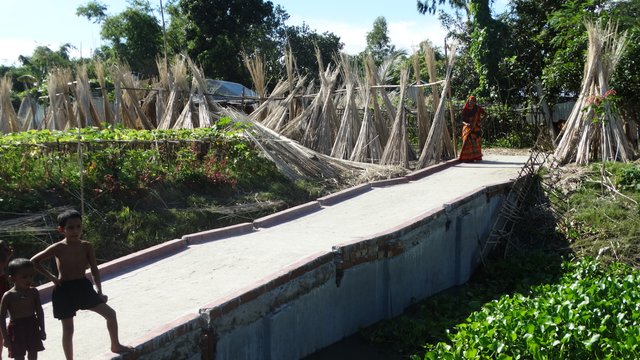
Disability inclusive, flood resilient cluster village [Bangladesh]
The inclusive, flood-resilient cluster village provides safe housing, food security and income generation for multiple families, including persons with disabilities, in a highly flood prone area of Gaibandha District in northern Bangladesh. The land was raised above flood level and is protected by deep rooted fruit trees to prevent soil …
- Compiler: Subir Saha
2. Description of the SLM Approach
2.1 Short description of the Approach
The disability inclusive approach is centered around the meaningful contribution and leadership of persons with disabilties during the entire project management cycle, from the planning stage to the evaluation of the impact of a project. It contributes to empowering them to overcome social exclusion and recognizes their needs and priorities as persons who are disproportionally at risk of disaster.
2.2 Detailed description of the Approach
Detailed description of the Approach:
The main charactistic and central feature of the approach is that persons with disabilties can actively and meaningfully participate in, contribute to and benefit from sustainable land management/disaster risk reduction activities. The implementing organization needs to invest sufficient time and financial ressources into the formation and strenthening of self-representation groups of persons with disabilities and support their active engagement with the local government and the wider community to address the physical and attitudinal barriers that hinder their full participation in the project and society in general.
The aim is twofold: On the one hand, the participation of persons with disabitities ensures that their needs and priorities are fully taken into account in the project design and implementation, to ensure that they can benefit equally from it. On the other hand, it contributes to reducing barriers beyond the project and empowers them to demand their rights in other areas of human development, like education, health or livelihood.
The main stages of disability inclusion in the implementation of a SLM/DRR technology are:
1) Formation of self-help groups for persons with disabilities,
2) trainings and other capacity development activities for the groups, including rights awareness sessions and organizational management trainings,
3) set up the collaboration between the groups and the local government and with other members of the community,
4) participation of persons with disabilities/group members in the planning phase to decide on the technology and adapt the technology to universal design standards, which takes into account their needs and the needs of other groups with other specific accessiblity needs, like the elderly or pregnant women,
5) persons with disabilities (together with other land users) support the introduction of the technology (including the construction activities) by providing manual labor and supervision functions
6) full handover of the technology to land users, ensuring Joint ownership includes persons with disabilities, and provision of trainings for self-maintenance,
7) participation of persons with disabilties in the evaluation of the impact of the technology, sharing of lessons and good practices and continuous advocacy for community development and for the rights of persons with disabilties.
Experience from Bangladesh shows that what the land users, including persons with disabilties, like about the approach is: The strong community engagement, the empowerment and increased status of persons with disabilities, the collaboration between persons with disabilities and persons without disability, and the adaptation of existing technology to fit the needs of persons with disability.
2.3 Photos of the Approach
2.5 Country/ region/ locations where the Approach has been applied
Country:
Bangladesh
Region/ State/ Province:
Gaibandha District
Further specification of location:
Horipur Union, Sundargonj Sub district
Map
×2.6 Dates of initiation and termination of the Approach
Indicate year of initiation:
2015
Year of termination (if Approach is no longer applied):
2016
Comments:
Project "Disability inclusive, flood resilient cluster village" implemented from December 2015 to September 2016.
2.7 Type of Approach
- project/ programme based
2.8 Main aims/ objectives of the Approach
To empower persons with disabilities to meaningfully participate in, contribute to and benefit from the implementation of an SLM/DRR technology.
2.9 Conditions enabling or hindering implementation of the Technology/ Technologies applied under the Approach
social/ cultural/ religious norms and values
- hindering
The social stigma and exclusion, that persons with disabilities experience in rural Bangladesh, was a challenge for the project. Persons with disabilities are sometimes believed to be incapable of contributing anything meaningful to society and village life. Some community members did not want to associate with persons with disabilities. This required an extra effort to ensure the participation of the wider community in the project and it required sustained advocacy and awareness raising for the rights and dignity of persons with disabilities.
availability/ access to financial resources and services
- enabling
The financial resources for the implementation of the technology and the extra ressources needed to ensure disability inclusion, were readily available because the technology was widely and positively recognized by the community and by donors.
institutional setting
- enabling
The institutional environment was overwhelmingly supportive of the implementation of the project. The local Union Council government, schools, mosques and other civil society organizations were in favor of the technology and approach and supported the implementation.
collaboration/ coordination of actors
- enabling
Beneficiaries/land users were selected in a participative process, involving the whole community. The process was transparent and inclusive. It was a foundation for the smooth collaboration with beneficiaries and other involved stakeholders later on.
legal framework (land tenure, land and water use rights)
- enabling
To ensure joint ownership of beneficiaries of the land on which the SLM/DRR Technology was implemented, an exchange of land was needed. Due to the remoteness and scarce population of the implementation area in rural Bangladesh, a cooperative local government and a manageable legal framework this was easy to achieve.
A deep-rooted tube well was installed for water access of the land users. Water use rights were also easy to acquire.
policies
- enabling
No specific policies existed, which significantly affected the implementation of the technology.
land governance (decision-making, implementation and enforcement)
- enabling
Land ownership was recognized by the local government and land governance was controlled by land owners.
knowledge about SLM, access to technical support
- enabling
Indigenous knowledge about SLM was enabling for the implementation of the technology. Technical expertise by the implementing organization (NGO) was available.
markets (to purchase inputs, sell products) and prices
- enabling
Inputs for construction and planting were locally available at reasonable prices.
workload, availability of manpower
- enabling
During the lean season manpower was abundant in the area, but it was scarce during the planting season. The workload for the implementation of the technology was manageable and could easily be provided by land users themselves.
3. Participation and roles of stakeholders involved
3.1 Stakeholders involved in the Approach and their roles
- local land users/ local communities
The land users include 10 families who jointly own and inhabit the land of the cluster village.
Land users were closely engaged in the implementation of the technology by participating in decision making processes, informing the design of the technology and contributing to the construction process.
- community-based organizations
Self-help (self-representation) groups of persons with disabilities are informal community based groups of 15 persons with different types of disabilities (physical-, sensory- and mental disabilities).
The group is closely engaged in the implementation of the technology. It participates in decision making processes, informs the design of the technology, contributes to the construction process, is engaged in the evaluation of the technology and the sharing of learnings about it to the wider community.
The group also provides benefits for its members by supporting them with everyday challenges, which can be of economic, legal or social nature, and promotes the rights of all persons with disabilities in the community.
- NGO
The implementing NGOs included an international and a local organization in partnership (CBM and CDD).
CDD was responsible for the overall management of project implementation and the collaboration with other involved local stakeholders. CBM provided training and technical support.
- local government
The Union Parishad government is the lowest level of local government.
The Union Parishad government managed land ownership and approved construction projects.
3.2 Involvement of local land users/ local communities in the different phases of the Approach
| Involvement of local land users/ local communities | Specify who was involved and describe activities | |
|---|---|---|
| initiation/ motivation | interactive | Land users contributed to the initial situation analysis and joined self-help groups for persons with disabilities. |
| planning | interactive | Land users, and in particular those who are persons with disabilities, participated in all planning and decision making processes related to the design and introduction of the technology, including the selection of the land. |
| implementation | external support | Land users engaged in the construction of the technology by providing paid and unpaid labor. |
| monitoring/ evaluation | interactive | The land users monitored the implementation process and gave feedback to the implementing NGOs when changes were needed. Land users participated in the evaluation of the technology and the approach and contributed to the dissemination of good practices and learnings. |
3.3 Flow chart (if available)
Description:
Not available.
3.4 Decision-making on the selection of SLM Technology/ Technologies
Specify who decided on the selection of the Technology/ Technologies to be implemented:
- all relevant actors, as part of a participatory approach
Explain:
The cluster village technology was known to the community before the implementation. The technology was suggested by the implementing NGOs to the community, which supported its implementation. The technology was adapted to fit the needs of persons with disabilities based on the decisions of land users with technical support of the implementing NGOs.
Specify on what basis decisions were made:
- evaluation of well-documented SLM knowledge (evidence-based decision-making)
4. Technical support, capacity building, and knowledge management
4.1 Capacity building/ training
Was training provided to land users/ other stakeholders?
Yes
Specify who was trained:
- land users
- field staff/ advisers
If relevant, specify gender, age, status, ethnicity, etc.
10 males and 15 females, aged between 18 to 55. Three were persons with disabilities. Most of them were daily laborers and share croppers.
Form of training:
- on-the-job
- demonstration areas
- courses
Subjects covered:
On the job training and demonstration on the construction and maintenance of the technology. Training to self-help groups for persons with disabilities on the rights of persons with disabilities, the use and benefits of the technology for persons with disabilities and the management of self-help groups.
Comments:
Training Subjects were: 1) Group dynamics and Development, 2) Disability inclusive DRR 3) Tree plantation and Vegetable Gardening using organic fertilizer 4) Government safety nets and Rights of the persons with disabilities.
4.2 Advisory service
Do land users have access to an advisory service?
Yes
Specify whether advisory service is provided:
- on land users' fields
- construction/implementation of technology
Describe/ comments:
The implementing NGOs provided detailed technical support to land users on the adaptation of the technology to the needs of persons with disabilities, following the standards of universal design.
4.3 Institution strengthening (organizational development)
Have institutions been established or strengthened through the Approach?
- yes, moderately
Specify the level(s) at which institutions have been strengthened or established:
- local
Describe institution, roles and responsibilities, members, etc.
Local self-help groups and their APEX body (umbrella group) at Union level were strengthened. Their roles of the self-help groups were to establish a mutual support network, raise awareness among group members of disability rights and development issues, pool ressources and give individual persons with disabilities a greater political voice. The APEX body gave the groups contact points beyond their immediate community and gave further weight to their political voice.
Specify type of support:
- financial
- capacity building/ training
- equipment
Give further details:
To strengthen self-help groups, they were provided with, 1) awarness- and skill development trainings, 2) financial support for climate resilient income generation through agricultural and non-agricultural activities, and 3) assistive devices.
4.4 Monitoring and evaluation
Is monitoring and evaluation part of the Approach?
Yes
Comments:
A participatory monitoring and evaluation system was implemented with support of the self-help groups for persons with disabilties.
If yes, is this documentation intended to be used for monitoring and evaluation?
No
4.5 Research
Was research part of the Approach?
No
5. Financing and external material support
5.1 Annual budget for the SLM component of the Approach
Indicate the annual budget for the SLM component of the Approach in US$:
218702.00
If precise annual budget is not known, indicate range:
- 100,000-1,000,000
Comments (e.g. main sources of funding/ major donors):
The annual budget includes the total funds used for the introduction of the technology. Funds were provided through the implementing NGOs CBM and CDD, with the support of a private donor from Germany.
5.2 Financial/ material support provided to land users
Did land users receive financial/ material support for implementing the Technology/ Technologies?
Yes
If yes, specify type(s) of support, conditions, and provider(s):
Land users received a daily fee for the labor provided for the introduction of the technology. The NGOs also provided most material input for the technology, including soil, sand, seeds, seedlings, grass, trees, ramp, water and sanitation facilties.
5.3 Subsidies for specific inputs (including labour)
- labour
| To which extent | Specify subsidies |
|---|---|
| partly financed | Labor provided by land users for certain construction actvities was compensated with a daily fee. |
- equipment
| Specify which inputs were subsidised | To which extent | Specify subsidies |
|---|---|---|
| machinery | fully financed | Rent of sand extravation machine was funded by the project. |
| tools | fully financed | Tools for construction activities was provided to land users by the project. |
- agricultural
| Specify which inputs were subsidised | To which extent | Specify subsidies |
|---|---|---|
| seeds | fully financed | Seeds and seedlings for the homestead garden was provided by the project. |
| fertilizers | partly financed | The facility for composting organic fertilizer was provided by the project. |
| Plants | fully financed | Deep-rooted fruit trees and grass turfing was provided by the project. |
- construction
| Specify which inputs were subsidised | To which extent | Specify subsidies |
|---|---|---|
| wood | partly financed | Wood for fencing for the homestead vegetable garden in front of all houses and a flood resilient cow sheds in the village was provided by the project. |
| Soil | fully financed | The purchase of soil for the raising of land was funded by the project. |
- infrastructure
| Specify which inputs were subsidised | To which extent | Specify subsidies |
|---|---|---|
| roads | partly financed | Construction material for barrier free connections to all houses in the village was funded by the project. |
| Ramp | fully financed | A ramp, connecting the cluster village with the road was funded by the project. |
If labour by land users was a substantial input, was it:
- paid in cash
Comments:
A daily fee of 300 Taka was provided for labor inputs by the land users.
5.4 Credit
Was credit provided under the Approach for SLM activities?
No
5.5 Other incentives or instruments
Were other incentives or instruments used to promote implementation of SLM Technologies?
No
6. Impact analysis and concluding statements
6.1 Impacts of the Approach
Did the Approach empower local land users, improve stakeholder participation?
- No
- Yes, little
- Yes, moderately
- Yes, greatly
The approach is based on the empowerment of land users, in particularly those who are persons with disabilites. It ensured participation of persons with disablities who would otherwise be isolated and excluded.
Did the Approach enable evidence-based decision-making?
- No
- Yes, little
- Yes, moderately
- Yes, greatly
Did the Approach help land users to implement and maintain SLM Technologies?
- No
- Yes, little
- Yes, moderately
- Yes, greatly
The project supported land users with the implementation and use of the technology.
Did the Approach improve coordination and cost-effective implementation of SLM?
- No
- Yes, little
- Yes, moderately
- Yes, greatly
The coordination among land users has improved and actions of land management have become more cost effective.
Did the Approach mobilize/ improve access to financial resources for SLM implementation?
- No
- Yes, little
- Yes, moderately
- Yes, greatly
Did the Approach improve knowledge and capacities of land users to implement SLM?
- No
- Yes, little
- Yes, moderately
- Yes, greatly
Land users were provided with trainings and demonstrations about the implementation and use of the technology.
Did the Approach improve knowledge and capacities of other stakeholders?
- No
- Yes, little
- Yes, moderately
- Yes, greatly
The local goverment, other members of the community and other non-governmental organizations took note of the technology and sensitization about the rights and needs of persons with disabilties increased.
Did the Approach build/ strengthen institutions, collaboration between stakeholders?
- No
- Yes, little
- Yes, moderately
- Yes, greatly
The approach strengthened the collaboration between the local government and self-help groups of persons with disabilities.
Did the Approach mitigate conflicts?
- No
- Yes, little
- Yes, moderately
- Yes, greatly
Joint decision making and the resolution of conflicts among land users improved through the joint managment of the land.
Did the Approach empower socially and economically disadvantaged groups?
- No
- Yes, little
- Yes, moderately
- Yes, greatly
The approach empowered persons with disabilities and other land users, who all belonged to economically marginalized groups. Their social and economic status greatly improved.
Did the Approach improve gender equality and empower women and girls?
- No
- Yes, little
- Yes, moderately
- Yes, greatly
Land user participation in the implementation of the technology always included men and women. Self-help groups for persons with disabilities, which were formed and strengthened by the project, always included around 50% women. Meaningful participation by women in group meetings was promoted by the implementing NGOs.
Did the Approach encourage young people/ the next generation of land users to engage in SLM?
- No
- Yes, little
- Yes, moderately
- Yes, greatly
The technology was of of high interest for youth clubs, high school students and other young people in the community and many voiced the intention of replicating it in the future.
Did the Approach improve issues of land tenure/ user rights that hindered implementation of SLM Technologies?
- No
- Yes, little
- Yes, moderately
- Yes, greatly
Did the Approach lead to improved food security/ improved nutrition?
- No
- Yes, little
- Yes, moderately
- Yes, greatly
The technology improved food security and nutrition through the introduction of fruit tree plantation and a homestead vegetable garden.
Did the Approach improve access to markets?
- No
- Yes, little
- Yes, moderately
- Yes, greatly
The construction of a ramp for road access allows wheelchair users and other persons with limited mobility to better access local markets.
Did the Approach lead to improved access to water and sanitation?
- No
- Yes, little
- Yes, moderately
- Yes, greatly
The technology improved water access through the drilling of a deep bore hole water source for common water access and the construction of barrier free household latrines.
Did the Approach lead to more sustainable use/ sources of energy?
- No
- Yes, little
- Yes, moderately
- Yes, greatly
The technology lead to more sustainable energy use through the provision of household based mini solar systems.
Did the Approach improve the capacity of the land users to adapt to climate changes/ extremes and mitigate climate related disasters?
- No
- Yes, little
- Yes, moderately
- Yes, greatly
The technology offers a safe and accessible space for housing, fruit and vegetable cultivation and livestock shelter. It greatly improved the capacity of land users to adapt to the increasing occurence and intensity of monsoon floods.
Did the Approach lead to employment, income opportunities?
- No
- Yes, little
- Yes, moderately
- Yes, greatly
The technology improved income opportunities through the introduction of a flood resilient fruit tree plantation and homestead vegetable garden. Part of the harvest can be sold on the market.
6.2 Main motivation of land users to implement SLM
- increased production
Vegetable production and fruit production increased and is more flood resilient.
- reduced land degradation
Soil erosion and land degradation in the custer village reduced.
- reduced risk of disasters
Reduction of disaster risk was the main motivating factor for land users. The cluster village is a flood-resilient safe-place providing shelter for the whole community, including their livestock, during flood season.
- reduced workload
Household works and household based income generating activities have become easier to organize because of the safety and reliable energy supply that the cluster village provides.
- affiliation to movement/ project/ group/ networks
Joint ownership of the cluster village by land users, who all belonged to an economically marginalized part of the community (daily laborers and share-croppers) and the formation of self-help groups for persons with disabilities, have greatly improved social cohesion among land users.
6.3 Sustainability of Approach activities
Can the land users sustain what has been implemented through the Approach (without external support)?
- uncertain
If no or uncertain, specify and comment:
The maintenance of the cluster village (including grass turfing, tree plantation, vegetable garden, solar panels, water and sanitation facilities) is currently managed by land users themselves . Long-term sustainability cannot be evaluated yet.
6.4 Strengths/ advantages of the Approach
| Strengths/ advantages/ opportunities in the land user’s view |
|---|
| Land users greatly apprechiate the empowerment and social cohesion that the approach enabled. Decisions are taken together and conflicts in the village can be mitigated. The Cluster Village has become a safe space and meeting point for the whole community. |
| The Cluster Village is fully inclusive of persons with disabilities (inclusion in decision making processes and social activities and fully accessible infrastructure), which is something that land users are proud of because it is the first such set-up in the community and is apprechiated as a model by others. |
| Strengths/ advantages/ opportunities in the compiler’s or other key resource person’s view |
|---|
| Meaningful participation and of persons with disabilities in project implementation has a signaling effect beyond the project and fosters sensitization of the local government and wider community for more inclusive community development and principles of universal design. |
| Formation of self-help groups of persons with disabilities and their active engagement with the wider community on community development issues, which go beyond the rights and needs of persons with disabilites, lead to empowerment and geater social inclusion of persons with disabilities. |
6.5 Weaknesses/ disadvantages of the Approach and ways of overcoming them
| Weaknesses/ disadvantages/ risks in the land user’s view | How can they be overcome? |
|---|---|
| Technical knowledge gap when it comes to the maintenance of the technology and the continuous dependence on external support. | Invest sufficient ressources in trainings and capacity building and emphasis and formalize the transfer of ownership of the technology to land users. |
| Weaknesses/ disadvantages/ risks in the compiler’s or other key resource person’s view | How can they be overcome? |
|---|---|
| Formation and strenthening of self-help groups of persons with disabilties to the level where they are sustainable and able to make significant contributions to the projects and community development and demand their rights, takes significant ressources with regard to time and funds invested. | Strong committment of the implementing organization to inclusive programming and sufficient internal capacity building. |
7. References and links
7.1 Methods/ sources of information
- field visits, field surveys
6
- interviews with land users
10
- interviews with SLM specialists/ experts
2
- compilation from reports and other existing documentation
5
7.2 References to available publications
Title, author, year, ISBN:
Disability inclusive disaster risk managment, CBM, 2013
Available from where? Costs?
http://www.cbm.org/article/downloads/54741/Disability_Inclusive_Disaster_Risk_Management.pdf
Links and modules
Expand all Collapse allLinks

Disability inclusive, flood resilient cluster village [Bangladesh]
The inclusive, flood-resilient cluster village provides safe housing, food security and income generation for multiple families, including persons with disabilities, in a highly flood prone area of Gaibandha District in northern Bangladesh. The land was raised above flood level and is protected by deep rooted fruit trees to prevent soil …
- Compiler: Subir Saha
Modules
No modules


